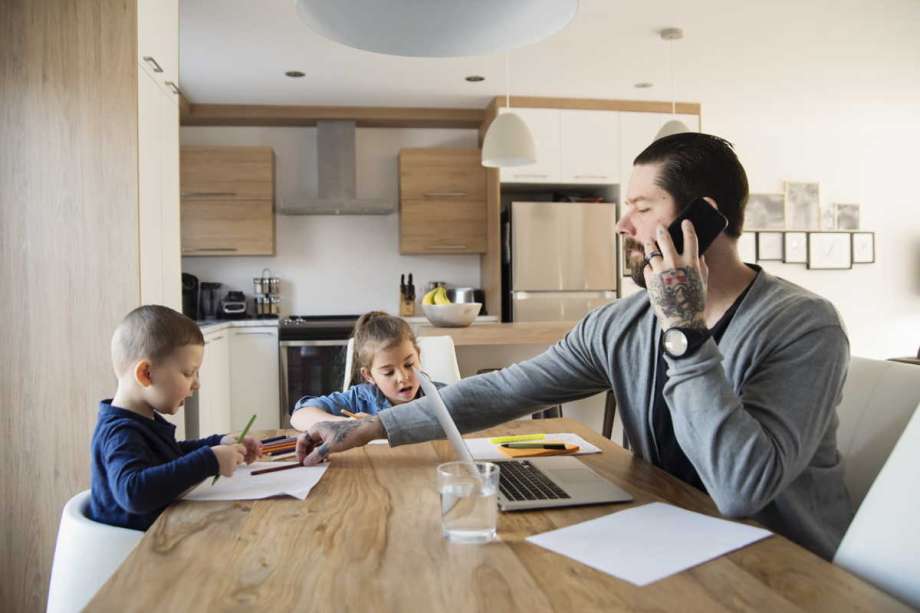The Ultimate Guide to Working From Home With Kids

As parents, we are in unprecedented times right now as we tackle both working from home and guiding our children through their remote learning journeys. Not to mention that we are doing this in a time of crisis as we face the COVID-19 global pandemic. If you’re not used to working from home, that alone would be stressful during normal times. If you’ve never homeschooled, this alone would be challenging. Combine all of these factors, and parents have a perfect storm of anxiety and stress on their hands.
More: Parenting Mindfully When Life Spirals Out of Control
Fortunately, there are ways to make working from home with kids more peaceful. This is a situation that will take some flexibility and patience, though you are not alone if you feel very short on that these days. With the help of these eight strategies, little by little, your family can adjust as peacefully as possible to this new reality.
Have Family Meetings
Your kids feel as uncertain and confused and stressed as you do these days, whether they explicitly express that or not. Being honest about your challenges and what you need help with is more important than ever as it models the behavior that you want to see from them. It also provides them with the opportunity to help you and the family, and generally speaking, everyone feels better when they feel like they are contributing to a greater good.
Starting and ending your day with a brief family meeting can be very helpful. This shouldn’t feel like another thing taking up time on your agenda. It can be as short as five minutes. It’s simply a chance to set expectations by sharing your schedule and your concerns and to hear your children’s concerns in return. Likewise, at the end of the day, you can create a practice of reviewing the positives and negatives of your day together. Be sure to ask your kids how they feel the day went and to get their feedback on suggestions for how you can all do better tomorrow.
Visually Display Schedules
Organization helps everyone feel more comfort during a difficult time. It can also help to create a routine which helps both adults and children to get through the day more easily. Having visual representations of the schedule which are easily accessible to everyone throughout the day can be a big help. Using a whiteboard or an easel, or simply taping a big piece of paper to the refrigerator are easy visual cues.
For non-readers or emerging readers, use pictures to delineate time of day and activities on your schedule. You can use pictures of each family member to show who is doing what at which time. Chunk the day into times where each family member takes time to do their individual “work” as well as times of day when the family can come together to connect, even if it is for short periods of time.
Set up Individual Work or Play Spaces for Each Family Member
It’s important for everyone to have their own space with all of this extra togetherness. Having a work space also provides each family member with a cue that it’s time to get to work. This may take some shifting of furniture and creative use of space, but it will be worth it. The less distraction and overlap of work space, the better.
To keep younger children busy while you are working, consider setting up play stations for their work or learning space. Changing out these play stations everyday or every few days can help keep children busy thanks to novelty. You can use the same toys over and over. It’s all about changing up the presentation of toys and crafts and resources to make them seem more interesting to kids.
Anticipate Needs and Create Set Choices
During family meeting times, it can be very helpful to go through scenarios that you expect will come up throughout the day. For instance, if Mommy is on a conference call, and you need a snack, your three snack choices for the day will be on the table. Or, if you have a question that can’t wait, slipping a note under the door will be the only way to let Daddy know if it happens during his “Do Not Disturb Hour.” The more you practice these scenarios with kids, the better they will do during your actual work day. You can also write these rules out to be displayed throughout the day.
Don’t have time to read now? Pin it for later:
Be Creative With Your Schedule
If at all possible, determine which parts of your work day can be accomplished when it is not prime time for the kids to be needing your assistance. Can you wake up an hour early? Can you save an hour of work for after the kids are in bed?
Ask yourself which parts of your day can be handled outside typical work hours. Consider tasks like email response time, presentation or document creation, busy work types of activities, and professional development tasks as pieces of your day which you can chunk into less busy times of the day for your family as a whole.
Keep a Running List of “Busy Activities” For the Kids
No matter how much you plan, there will be times when you just really need your kids to be occupied for a chunk of time so you can get work done. Keep a running list of activity options that you know will keep them busy for whenever you need it. Maybe you put on a kids’ movie or educational TV show. Other options can include things like tablet time, trampoline time, water tables outside, Play-Doh, pre-made craft boxes, puzzles, sensory bins, and so much more. The more organized you are with go-to busy activities, the easier it will be for you to implement them in a pinch.
Keep a Running List of “Breaks” for the Whole Family
These can be five to 15-minute activities that will give you all a chance to be together, de-stress, and connect. Be sure to schedule these breaks throughout your day.
You might consider having links to quick family meditation or yoga videos so you can be active together in a fun way. Maybe you all go outside and run or jump up and down for five minutes. Maybe you sing a favorite song together or play one song’s worth of Freeze Dance. You all need breaks more than ever so keep a long list of options to choose from. You can even keep a jar of ideas that you randomly choose from at each break to make it more exciting.
Manage Your Expectations
Finally, have grace both with yourself and with your family members. No one is at their best right now. We are all acting out in various ways. Do not expect to replicate a school day or to be your best work self. Offer that same grace to your work teammates and colleagues. The more we all feel like we are in this together, the better off we will all be. If your child hits a wall with schoolwork for a day, so be it. There is nothing more important than our health right now, and that includes our social emotional well-being.
Do what you can, and let the rest go. We don’t have the capacity for perfectionism and high standards right now. Most importantly, when your work time is over for the day, do your best to be fully present with your family. Having time to feel fully connected is the most important comfort we can offer each other as we move through this time of crisis. Just take one day at a time and know that you are not alone.
Looking for ways to keep the kids busy and learning during social distancing? Sign up for the Prepared Parent, a daily newsletter filled with everything to help mom and dad in their roles as teacher-parents.

